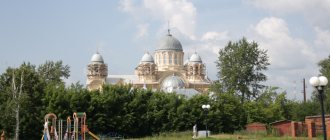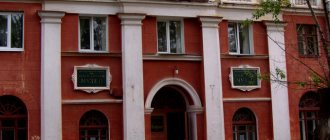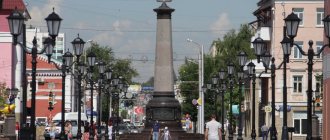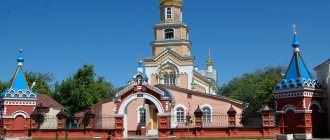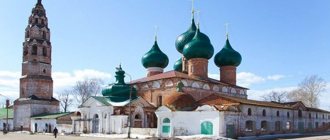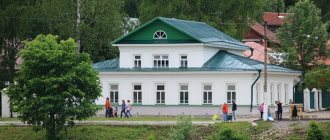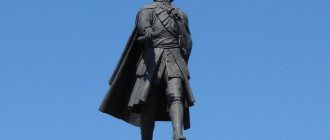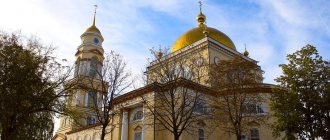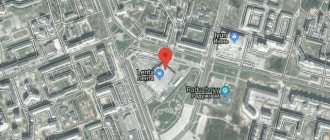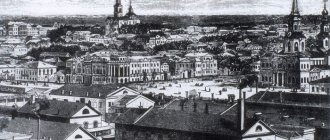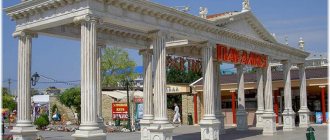Verkhoturye: areas, recreation, excursions, museums and churches, cuisine and restaurants, shopping and shops, attractions of Verkhoturye.
- Last minute tours
to Russia
Ural Jerusalem, an amazing region where a huge number of holy places, churches and monasteries are concentrated, is located on the Tura River in the Sverdlovsk region, 300 km from Yekaterinburg. An amazing silence envelops the guests of the modest town of Verkhoturye, and is broken only from time to time by the ringing of bells.
They say that Grigory Rasputin became an “old man” just after his pilgrimage to Verkhoturye.
How to get there
The most convenient way to get to Verkhoturye is by car. From Yekaterinburg you need to drive 275 km along the Serovsky tract, then turn at the sign “Verkhoturye” and drive another 30 km. Travel time is approximately 4 hours. Another landmark that will definitely not let you deviate from the intended path is a sign to the village of Nikolo-Pavlovskoye.
You can also get there by bus from Yekaterinburg (2-3 departures per day from the Northern and Southern bus stations, travel time is about 5 hours). Buses also run from Nizhny Tagil, the journey takes about 3 hours.
Finally, trains and electric trains run along the Serov - Priobye line, Verkhoturye station. From Yekaterinburg 2-3 times a day they will cover this route in about 5-7 hours. From Nizhny Tagil, trains take from 2.5 to 4 hours. You can get there by train through Perm in 9-10 hours.
Another option is to join believing travelers, for whom trips are organized at the pilgrimage department of the Ekaterinburg diocese, telephone.
Search for flights to Verkhoturye at minimal prices
#18 Church of the Nativity in the village of Deryabino
The Russian word "deryaba" had the meaning of a bully, a hooligan; and in 1680 the Deryabin became the founders of a settlement on the way from Verkhoturye to Alapaevsk . Until now, the surname “Deryabins” is the most common among village residents.
The temple was founded back in 1794, there are few facts about its history, so I will digress into the lyrics and photographs in which I tried to capture the spirit of this place, the spirit of a very touching ship-temple, a monument to Faith, only partly church, but mostly faith to the strength of those same fighters and bullies who in the 17th century mastered the routes to Siberia.
the village of Krasnogorskoye , in Prokopyevskaya Salda (the local temple is associated with the legends of Governor Gagarin ), in Ust-Salda and the village of Piya
will be of interest . You can read about them in other publications, but within the framework of our journey and report on it, additional temples will already be a serious overdose.
Sretenskaya Church, village. Prokopyevskaya Salda. According to legend, it was built by the descendants of the first Siberian governor Gagarin.
Peter and Paul Church, p. Ust-Salda
In general, from the moment you arrive in Verkhoturye , a feeling of farce covers you - standing on the central square of the town, you can see the huge Cathedral of the Exaltation of the Cross (the youngest and most fashionable church in the city’s Orthodox circles), the lace ligature of the Trinity Cathedral (the oldest church), and the ruins of several churches of the 18th century, which are being destroyed more and more every year. The contrast between several objects in which huge amounts of money have been invested over the past 20 years, and hundreds (I was not mistaken) of buildings that created the historical flavor of a provincial town is amazing. Add to this the extremely undeveloped infrastructure - and a trip to Verkhoturye and the region will no longer seem so attractive... Nevertheless, it is worth going here, if only for the sake of the museum.
Hotels and cafes
It’s hard to cover all the historical riches of the city in one day, so you can stop for the night in the courtyard of the Novo-Tikhvin Convent in the village of Merkushino. Please note: this hotel does not accommodate non-believers. Pilgrims will also be received at the hotel at the monastery, but 13 people will have to sleep in a room.
A more secular option is the only Sobol Hotel in the city, but you need to book a room in advance. Single standard room costs 1750 RUB. Don't expect luxury.
Verkhoturye is a small town and there are no restaurants here, only snack bars, canteens, dumpling shops, kebab shops (right next to the temple) and one cafe with pretentious names. Local residents mostly eat at home, so there is practically no place to have dinner here: the maximum is breakfast and lunch.
Prices on the page are for May 2022.
A little history
This Ural city was built on the Ture River, which flows in the Sverdlovsk region. A little earlier the city belonged to the Perm province.
The history of Verkhoturye dates back to 1597, when Ermak conquered Siberia and the Urals. There was originally a fortress of the Maxi people here. Then it was converted into a prison. Then Verkhoturye was made a customs house. All the goods that Siberia is rich in passed through this settlement.
Two government decrees contributed to the flourishing of the city:
By decree, the Russian state monopolized the fur trade. All transactions with Russian merchants, maxi and local residents were made here, at Gostiny Dvor.
By decree, a Yamsk service was established, the paths of which crossed Verkhoturye. This was very beneficial for the city - the construction of other means of communication nearby, in the same area, was prohibited.
In the middle of the 17th century, the city was intensively developed and built. The population grew, residential areas filled up, churches and monasteries were built. Trade flourished.
In 1753, trade gradually subsided due to the abolition of duties. And by the middle of the 19th century, Verkhoturye ceased to be a trading center. Now this area is becoming a spiritual center: the number of monasteries and temples is growing.
On a note
Women should stock up on a scarf and a long skirt, and their makeup should be modest.
An excursion to Verkhoturye can be booked through a travel agency, the cost is from 2200 RUB and above. They don’t charge money for visiting the shrines, so traveling on your own will be cheaper (but with a guide, of course, it’s more interesting).
During excavations of the monastery, a pile of skulls was found. In the Simeon-Anninsky Church, by the light of the lamp, you will see the remains and the inscription on the wall: “We were like you, and you will be like us.”
#9 Ruins of the Resurrection Church
The temple is not the oldest, its construction began in 1786, but it is loved by architects and historians. This is because this is one of the few temples - “border guards”; they began to build it in the Baroque style, and finished it in the style of classicism due to a change in fashion.
Therefore, the first and second floors are very different. Despite the very severe destruction, you can still see the decor and even paintings inside the temple. Alas, the condition of the foundations is such that no restoration threatens this object. Compared to the background of neighboring restored churches, this church is almost boring, but look at the photo of Prokudin-Gorsky , who photographed only what seemed important to him. And we can trust his taste.
Access to the ruins is open, we calmly got inside. It was especially interesting for children. With minimal care there are no threats.
Holy places of Verkhoturye
The sight of numerous domes, crosses and bell spiers cutting through the blue sky evokes awe even among convinced atheists. The main attraction of Verkhoturye is the smallest Kremlin in Russia, which visitors try to visit first.
Kremlin
The Kremlin (Website) stands on the high bank of the Tura River, and the view of the river from the cliff is breathtaking. From the bell tower of the Trinity Cathedral, where you can climb for a small fee, the entire city is visible at a glance. Unfortunately, only the Holy Trinity Cathedral has survived from the temple complex, as well as the eastern wall with the gate (they were recently restored), but from them you can appreciate the architectural beauty of the original.
It was the Trinity Cathedral that served as the main model for the active construction of the first churches and temples in Siberia.
Tours are offered around the Trinity Kremlin. Address: st. Sovetskaya, 6, opening hours: from 08:00 to 17:00, without breaks and weekends.
St. Nicholas Monastery
The next majestic ridge of buildings is the St. Nicholas Monastery, which consists of three churches: the Cathedral of the Exaltation of the Cross, the Transfiguration and Simeon-Anninskaya gate churches. The word “gateway” in the name means that they are located above the entrances to the monastery territory.
The relics of St. Simeon of Verkhoturye, the patron saint of fishermen, are kept in the Cathedral of the Exaltation of the Cross. The interior design of the cathedral is stunning with its subtlety and touching icons, simplicity and at the same time restrained solemnity of the atmosphere.
The Exaltation of the Cross Cathedral in Verkhoturye is the third largest in Russia after the Cathedral of Christ the Savior in Moscow and St. Isaac's Cathedral in St. Petersburg.
Under Soviet rule, the monastery suffered a standard fate - there was a colony for juvenile delinquents here. During excavations, the remains of unknown monks were found in the Simeon-Anninskaya Church. In an ascetic setting, tourists see a pile of skulls illuminated by a lamp and an inscription on the wall: “We were like you, and you will be like us.”
Address of the monastery complex: st. Voinskaya, 1, the Holy Transfiguration Church is open from 07:00 to 21:00, cleaning break from 13:00 to 16:00.
The Holy Cross Cathedral is open all day long, seven days a week; there is also an Orthodox museum on the territory of the monastery, open from 09:00 to 17:00 every day, except Monday and Tuesday.
Historical and Archival Museum
Outside the walls of the monastery, right on the shore of the Kalachik pond, there is a wooden house of honored guests, in the form of an ancient Russian tower, now occupied by a historical and architectural museum-reserve. Address: st. Kuznechnaya, 13, opening hours: from 10:00 to 17:00, on Sunday from 10:00 to 14:00, closed on Monday.
Verkhoturye Kremlin
The Verkhoturye Kremlin is the smallest in Russia. It is located about 200 meters from the Nikolaevsky Monastery.
The main building on its territory is the Trinity Cathedral, built at the beginning of the 18th century and notable for the fact that there is a clock on its bell tower. Another interesting architectural detail is the floor, paved with cast iron slabs, which allows you to maintain a cool climate inside the cathedral even in the heat. The cathedral itself has the status of an architectural monument of world significance by UNESCO.
The interior decoration is quite modest, like all Verkhoturye churches. Frescoes and other decorative elements have not been preserved, and fairly new plaster is falling off the walls in places.
Also on the territory of the Kremlin there is a Museum of Local Lore with a permanent exhibition dedicated to the development of the Urals and the life of Verkhoturye. The exhibition is located on two floors, and entry to each floor costs 50 rubles. Total – 100 rubles per person for a full examination.
In the exhibition, the greatest interest is in ancient maps and household items, presented in the form of scenes from everyday life, but there are not as many of them as we would like. There are a lot of remakes at the exhibition, which often look too carnival and pretentious. All this is diluted with multimedia screens, on which copies of some ancient documents are displayed. It is impossible to understand what kind of documents these are, since no clear guide was found in the museum. The woman walking behind us answered all our questions in monosyllables and, it seemed, mainly made sure that we did not touch anything with our hands.
So, if you don’t have enough time, you can skip the excursion to the museum and instead admire the panorama of Verkhoturye and the famous suspension bridge from the Kremlin embankment. There is no equipped observation deck here, but let’s hope there will be one soon.
4 things worth doing in Verkhoturye:
- Visit the church shop of the St. Nicholas Monastery. This is the only place in the city where you can buy candles, icons, crosses and other church attributes.
- Stop by the neighboring town of Nevyansk, where the famous leaning tower stands. Locals say that Demidov minted counterfeit coins there and drowned all the witnesses in the basement of the tower. If you want to meet a ghost, you know where to go.
- Behind the church of the Nikolaevsky Monastery, find a small wooden chapel with a well on the banks of the Aktai River and in a special green “booth” douse yourself with life-giving water from the source. You need to pour 3 buckets of water on yourself, while you need to douse your head and not wipe yourself off.
- Take a walk along the rope bridge with log supports, for which you need to go down to the bank of the Tura. There are two such bridges in the city.
Type of clothing
Photo: clothes for visiting church
In general, special attire is not required to visit Verkhoturye. You just have to remember that if you go to monasteries or churches, you need appropriate clothing: men wear only trousers (shorts are not suitable), women and girls need to wear long skirts and headscarves. If for some reason you did not take such clothes with you, they are given at the entrance to the monasteries for the duration of your visit. It is better to choose shoes without heels - you will have to walk and stand on your feet a lot. Girls are not recommended to use lipstick and any other cosmetics, because... It is forbidden to touch the shrine of Simeon of Verkhoturye and the icons with makeup on your face.
Photo: clothes for visiting church
Other attractions of Verkhoturye
Do not miss a number of religious attractions of Verkhoturye: the Church of the Icon of the Mother of God “Znamenie” (Znamenskaya Church), the Church of the Resurrection of Christ (Spaso-Voskresenskaya Church), the Holy Intercession Convent, where the icon of Our Lady of Tenderness is kept, the Church of the Intercession of the Blessed Virgin Mary (Staro-Pokrovskaya church), in which fragments of wall paintings have been preserved, the Church of St. John the Baptist.
Verkhoturye is a land of amazing nature, so local residents often have picnics on the shores of the Verkhoturye hydroelectric power station or near the Bogorodsky spring.
A walk along Postnikov Street will also be of interest to history buffs: the ancient houses that once belonged to merchants and Lenin’s cousin, lawyer Ardashev, are well preserved.
Interesting Facts
Scroll:
- In 1913, Grand Duchess Elizaveta Feodorovna and her retinue arrived in the city, and she was later canonized.
- Verkhoturye is the smallest and most populous city in the Ural region.
- Despite the fact that the “Life-Giving Spring” near the monastery is replenished with water from a stormy river, the water in the well remains crystal clear.
- A strong fire in 1716 almost completely destroyed the Church of St. Nicholas the Wonderworker and nearby buildings, but the relics of the holy righteous Simeon, kept in a silver shrine, were not damaged.
- Despite the age of construction of the railway station, it is considered one of the most beautiful buildings of the Sverdlovsk railway.
- At the site of mass executions at the beginning of the 20th century in Verkhoturye, a worship cross was erected, to which pilgrims flock on holidays.
The sights of Verkhoturye are interesting for their primitiveness and history. In the atmosphere of the city one can sense a reverent attitude towards its culture and the beauty of the entire Ural region.
Author: Olga Zhanskaya
Article design: Oleg Lozinsky
Neighborhood
Not far from Verkhoturye is the village of Kostylevo, where the temple in honor of Blessed Kosma of Verkhoturye is being restored. 60 km from the city is the village of Merkushino, with which an interesting legend is associated.
In the 17th century, a righteous man named Simeon came here. Not having his own home, he went from hut to hut, sewing fur coats and hats, without taking money for the work, and paying only a table and a bed. Simeon was very ill and soon died and was buried next to the temple of the Archangel Michael. After 50 years, his coffin miraculously appeared on the surface of the earth, and it became clear that the old man’s body had not decayed. A spring began to emerge there, the water of which turned out to be healing. Since then, people from all over the region began to come to Merkushino for this water, and the relics of the saint were transferred to Verkhoturye.
#11 Ruins of St. John the Baptist Church
The ruins of St. John the Baptist Church are one of them.
The temple was built in 1754-1768. Now it’s hard to imagine that this temple adorned the city for more than 150 years. Only experts will see here hints of a magnificent example of the Ural Baroque: the structure, the remains of decoration on the facades, traces of paintings in the interior refer to the best churches of Solikamsk and Dalmatovo . What the temple looked like before 1917 can be seen in photographs by Prokudin-Gorsky .
You can imagine the reconstruction project of 2012.
Or you can look at the restored churches in Severouralsk and Karpinsk , which were built by the same artels according to the same project, commissioned by Pokhodyashin . It was thanks to Maxim Mikhailovich that settlements appeared in the 18th century, which would later become Severouralsk , Karpinsk ; Novolyalinsky and Krasnoturinsky districts .
Maxim Mikhailovich began with wine farming, and by the 1780s his factories provided more than a third of Russian copper. We don’t know whether the merchant-builder built the churches from the heart or as an indulgence, we don’t know, but I assure you that studying their style and history is a fascinating thing, just like the biography of Pokhodyashin . By the way, the children did not continue their father’s work. One of his sons, Gregory , is known as the largest donor to the projects of Nikolai Novikov , educator, freemason and public figure.
In addition to the connection with Maxim Pokhodyashin , the history of the convent is known by the names of Maria Khlopotova (the exiled bride of Mikhail Fedorovich Romanov , she was kept here in 1619-1621), and Princess Anna Dolgorukaya (she was also in exile here in 1740-1742). In general, they love the theme of exiled brides here, and the museum has a separate stand - a reconstruction with a weeping beauty.
Links[edit]
- "26. The size of the permanent population of the Russian Federation by municipalities as of January 1, 2022". Federal State Statistics Service. Retrieved January 23, 2022.
- "On the Calculation of Time". Official Internet portal of legal information
. June 3, 2011. Retrieved January 19, 2022. - Post office. Information and computing center of OASU RPO. ( Post office
).
Search for postal service objects ( postal Search for objects
) (in Russian) - Russian Federal State Statistics Service (2011). “All-Russian Population Census 2010. Volume 1" [All-Russian Population Census 2010, vol. 1]. All-Russian Population Census 2010 [All-Russian Population Census 2010]
. Federal State Statistics Service. - ↑
Federal State Statistics Service of Russia (May 21, 2004).
“The population of Russia, the constituent entities of the Russian Federation as part of federal districts, urban settlements, settlements, settlements is 3 thousand or more people” [Population of Russia, its federal districts, federal districts, districts Urban settlements, rural settlements - administrative centers and rural settlements with a population of over 3,000] (XLS). All-Russian Population Census 2002
. - “All-Union Population Census of 1989. The current population of union and autonomous republics, autonomous regions and districts, territories, negative phenomena, urban settlements and rural district centers” [All-Union Population Census of 1989: current population of union and autonomous republics, Autonomous regions and districts , territories, regions, districts, towns and villages performing the functions of district administrative centers. All-Union Population Census of 1989 [All-Union Population Census of 1989]
.
Institute of Demography of the National Research University: Higher School of Economics [Institute of Demography of the National Research University: Higher School of Economics]. 1989 - via Demoscope Weekly
.
